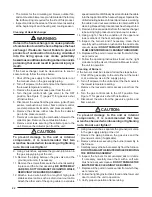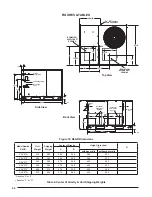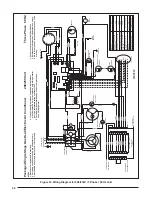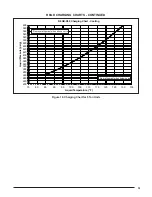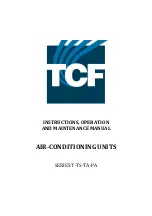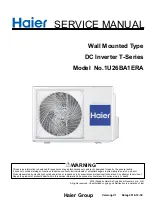
17
This unit only has right side gas entry. When connecting
the gas, provide clearance between the gas supply line
and the entry hole in the unit’s casing to avoid unwanted
noise and/or damage to the unit. A typical gas service
hookup is shown in Figure 8.
Table 11 (page 26) lists gas pipe capacities for standard
pipe sizes as a function of length in typical applications
based on nominal pressure drop in the line.
Leak Check
WARNING:
FIRE OR EXPLOSION HAZARD
Never test for gas leaks with an open fl ame. Check
all connections using a commercially available
soap solution. A fi re or explosion may result
causing property damage, personal injury or
loss of life. Failure to follow the safety warnings
exactly could result in serious injury, death or
property damage.
After the gas piping to the unit is complete, all connections
must be tested for gas leaks. This includes pipe connections
at the main gas valve, emergency shutoff valve and
other gas connectors. A soap and water solution can be
applied on each joint or union using a small paintbrush.
If any bubbling is observed, the connection is not sealed
adequately and must be retightened. Repeat the tightening
and soap check process until bubbling ceases.
• If pressure testing the gas supply lines at pressures
greater than 1/2 psig (14 inches WC), the unit must
be disconnected from the gas supply piping system
to prevent damage to the gas valve.
• If the test pressure is less than or equal to 1/2 psig
(14 inches WC), the unit must be isolated from the
gas supply line by closing the manual shut-off valve.
High Altitude Conversion
Conversion of this unit must be performed by qualifi ed
service personnel, using only approved parts. All
installations must be made in accordance with the National
Fuel Gas Code and/or local jurisdiction codes.
WARNING:
The reduction of input rating necessary for high
altitude installation may only be accomplished
with factory supplied orifi ces. Do not attempt to
drill out orifi ces in the fi eld. Improperly drilled
orifices may cause fire, explosion, carbon
monoxide poisoning, personal injury or death.
High altitude conversion can be fi eld performed by a
simple adjustment of manifold pressure or a change of
the orifi ces (if necessary) as described on page 20. The
changes required depend on the installation altitude and
the heating value of the gas (based on sea level) which
can be obtained from your local gas utility. The heating
value of gas at high altitude is always lower than the sea
level heating value. The heating values listed in Tables 6
& 7 (page 20) are based on sea level values.
If installing this unit above 2,000 feet, the input rate must
be reduced 4% per 1,000 feet of altitude (Example: 12%
at 3,000 feet, 16% at 4,000 feet, etc). NOTE: Deration is
necessary to compensate for low atmospheric pressure
at high altitudes.
For altitudes between 5,000 and 10,000 feet above sea
level, the unit can be converted by adjusting the furnace
manifold pressure. See Tables 6 or 7 for the correct manifold
pressure settings.
LP/Propane Gas Conversion
WARNING:
This unit was equipped at the factory for use
with natural gas only. A special kit, supplied by
the manufacturer, is required to convert the unit
to operate on LP/propane gas. Failure to use the
proper conversion kit can cause fi re, explosion,
property damage, carbon monoxide poisoning,
personal injury, or death.
Conversion of this equipment to LP/Propane gas must
be made by qualifi ed service personnel, using approved
factory parts. Conversion to LP can be accomplished by
replacing the natural gas orifi ces with the appropriate LP/
Propane orifi ces and then adjusting the manifold pressure
(page 20).
Conversion to LP/Propane (sea level and high
altitude) is detailed in the installation instructions provided
with the conversion kit. Please follow the instructions
provided in each kit. Approved conversion kits are:
• The United States LP/Propane Gas Sea Level and High
Altitude Conversion Kit is for LP/propane conversion in
the United States at altitudes between zero and 10,000
ft. above sea level.
• The Canadian LP/Propane Gas Sea Level and High
Altitude Conversion Kit is for LP/propane conversions
in Canada at altitudes between zero and 4,500 ft. above
sea level.
For installations between zero and 4,999 ft. above sea
level, a #54 drill size orifi ce should be used. Installations
5,000 ft. above sea level require a # 55 drill size orifi ce.
Table 7 (page 20) lists the correct orifi ce size to use at
different altitudes.
After changing the orifi ces, it is required that you measure
the gas input rate by clocking the gas meter and using
the local gas heating value. See Verifying and Adjusting
the Firing Rate section on page 19.




















